Two of the most common types of bird in the UK, the pigeon and the seagull have a number of similarities and differences.
They are both considered pests.
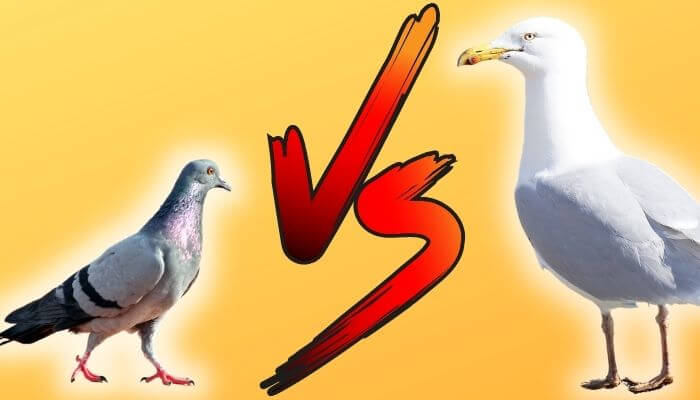
Pigeons are often described as flying rats while holidaymakers are never slow to complain about the gulls in their resort.
Pigeons
Thanks to pigeon breeding being a popular hobby, you’ll find many different types of pigeons.
Though there’s a wide-ranging representation of the 310+ breeds, many are small in number and are kept for showing and breeding, rarely seen by the general public.
The main types of UK pigeons are:
- Feral pigeon – By far the most common pigeon in the UK, the feral or wild pigeon has made itself right at home in all areas of the UK, adapting easily to an urban lifestyle. They often gather in huge numbers in city squares – after all who isn’t aware of the pigeons in Trafalgar Square where they are as much of a feature as Nelson’s Column.
- Racing and Homing pigeons – Often difficult to distinguish from wild pigeons, especially in flight, homing pigeons have an amazing built-in sense of direction which enables them to travel great distances and return home. Racing pigeons are bred for speed or endurance. There is a healthy interest in both in the UK with an estimated 60,000 pigeon owners, 42,000 of which race pigeons.
- Fancy pigeon – This is an umbrella term for a large number of breeds which are kept mainly for show purposes or as pets. They usually have some major distinguishing feature which might be, for example, curly feathers, ruffs, crests, muffed feet or spectacular colouring.
- Wood pigeon – The most common large wild bird in the UK, it is estimated there is a population of 2.5 million in our woods and forests. Known by its cooing call and loud flapping wings, it is not easily distinguishable from the wild pigeons in towns and cities.
Gulls
One of the first differences between the two species is that all pigeons belong to one genus – Columba and one family – Columbidae.
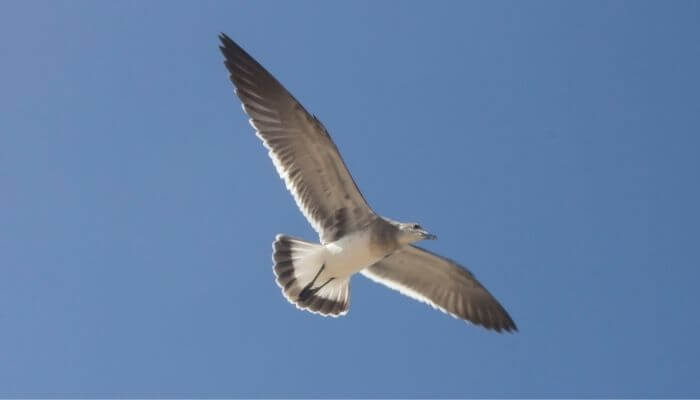
Gulls were all originally given a single classification of the genus Larus but because unlike pigeons, all the different types of gulls do not share a common ancestor.
Of the 50 types of gulls in the world, there are 6 common to the UK and another 3 types that come as winter visitors.
These are:
- Herring gull – One of the most common types, it is a large, noisy bird. You’ll find it around the UK coast, but inland it can be seen in large groups at landfill sites, rubbish tips, lakes and reservoirs, particularly in winter.
- Yellow-legged gull – Previously classified as a race of herring gull due to their similarities, distinguished by its yellow legs and darker wing tips, this gull is more common in Southern Britain.
- Lesser black-backed gull – Only found in Europe, 40 per cent are in the UK. They live at only a few sites giving rise to concern about their decline.
- Great black-backed gull – An aggressive thickset bird who will fight off other gulls to get at food. It is recognised by it black back, powerful beak and hunched look when perched.
- Common gull – With its greenish coloured legs, the common gull is abundant around the UK coast and in East Anglia. In winter it ventures inland to housing estates.
- Mediterranean gull – Known by its red beak and white wing tips, it is seen in the UK in increasing numbers. In winter, large numbers can be seen on beaches in Norfolk and Kent and all year, they are found along the southern and eastern coasts. They tend to live in the colonies of black-headed gulls in coastal wetlands and common gulls at reservoirs.
- Black-headed gulls – A grey, black and white sociable bird, it is found around the coast and inland. They flock in small numbers except when roosting or there is a plentiful supply of food nearby when their numbers swell.
- Black-legged Kittiwake – This medium-sized gull has a dark eye, small yellow bill and a grey back. They breed in the UK but in summer, leave to spend winter in the Atlantic. Some areas are seeing a decline in population, most likely due to reducing numbers of sand eels, the kittiwake’s food of choice.
- Little gull – True to its name, this is one of the smallest gulls. The UK’s population is seen all around the coast from July to April. In later summer months, larger numbers are concentrated between Yorkshire and Tayside with fewer numbers as you travel south. A popular place for little gulls in spring is the Alt Estuary in the Irish Sea.
Also Read: Seagull Pigeon Hybrids: Do They Exist + All You Need To Know
Pigeon Vs Seagull Distribution and Habitat
Pigeons are everywhere in the world except for the Arctic, Antarctica (it’s too cold for them there) and deserts and have large natural ranges.
They have adapted to almost every habitat except for the coldest and driest but some species have specific areas.
Gulls are everywhere other than tropical islands where only a few select breeds have evolved to the tropical climate.
Gulls are not just found by the ocean which is why “seagull” is not a recognised biological term.
Gulls can thrive in all habitats including coastal, fresh and saltwater wetlands, marshes and urban areas.
Size and Weight
| Pigeon | Seagull (Common Gull) | |
|---|---|---|
| Class | Aves | Aves |
| Order | Columbiformes | Charadriiformes |
| Family | Columbidae | Laridae |
| Weight | 300g | 400g |
| Wingspan | 74cm | 1.2m |
| Lifespan | 6 years | 10 years |
With more than 300 species, there is a huge range of height and weight among pigeons.
The smallest in the family is the New World Ground-Dove, which is comparable in size to a house sparrow, while the biggest, the Crowned Pigeon (endemic to New Guinea) grows to the size of a turkey with a weight of around 4 kg.
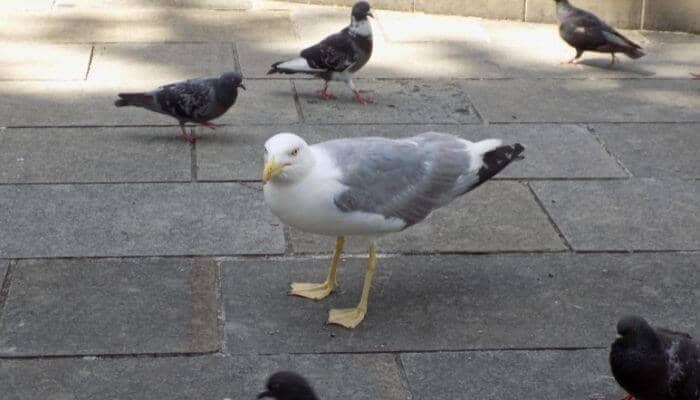
The most common pigeon in the UK, the feral/wood pigeon grows to between 25-30 cm with a weight of 300-500g.
Gulls too vary in size depending on species.
The smallest gull is the Little Gull (found mostly in Eurasia) which measures about 29 cm and weighs 120g while the largest gull, the Great Black-Backed Gull (which lives around Atlantic coastal areas), can reach a size of 76 cm and a weight of 1.75 kg.
Appearance
Both pigeons and gulls have a fairly standard appearance that makes them recognizable but there is much greater variation among pigeons.
Gulls follow a uniform shape of long wings, neck and legs with a heavy-set body and webbed feet.
The plumage color palette is limited to black, grey and white in varying shades. Bills are hook-shaped.
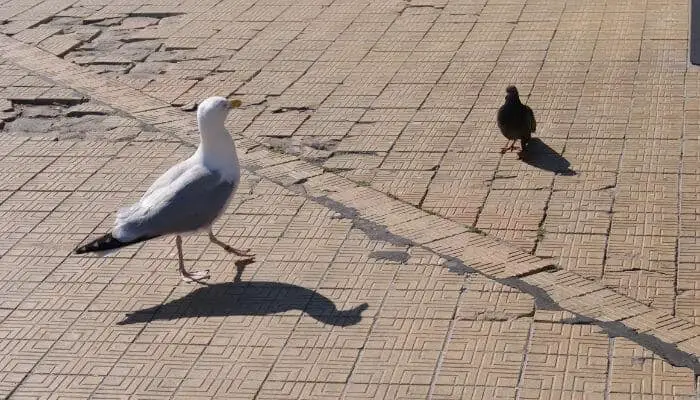
All pigeons have large bodies with small heads, long wings, short legs and short bills.
Plumage can vary greatly between species and breeds – particularly among the fancy pigeons.
Years of inter and selective breeding has resulted in the development of many possible different colours and features.
Behaviour and Character
Pigeons are appreciated for their intelligence and sociable character. They are easy to domesticate because of their gentleness and mild manner, even when they flock together in numbers of up to 500.
On the other hand, gulls can in no way be called gentle and mild. They fight and are aggressive, being particularly defensive if protecting their young.
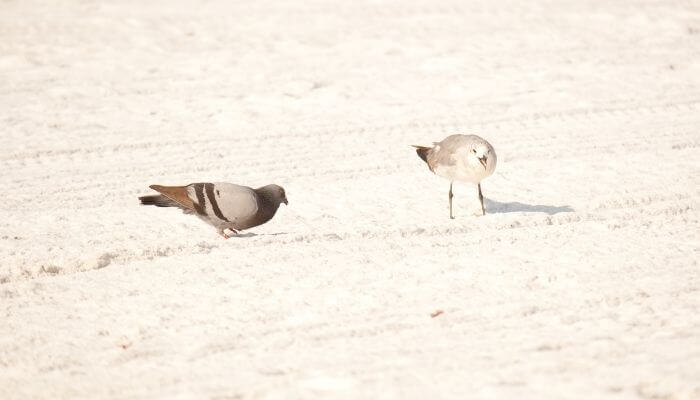
Unlike pigeons, they are territorial and as they steal food from other creatures, are well-known kleptoparasites. They too will flock together.
Pigeon Vs Seagull Diet
Pigeons are mostly vegetarian, eating seeds, grains, nuts and fruit but will supplement with worms, insects, snails, slugs, moths and small reptiles. They drink fresh water.
Gulls have a very varied diet.
Their menu includes fish, carrion, offal, eggs, insects, worms, reptiles, fruit, seeds and human refuse, and as well as fresh water, they can drink salt water.
Mating and Breeding
All birds have their own form of courtship. Male pigeons will strut and puff out his chest. He will try to impress the female with bows and turns and small repetitive sounds.
Pigeons most often mate for life but are happy to move nesting sites. Wild pigeons can breed up to 4 times a year, laying two eggs each time.
Gulls are also usually monogamous but will often return to the same breeding site. Unlike pigeons, most gull species will only mate once a year.
The gull courtship is typical of all seabirds. There are mate-attracting dances and behaviors such as flights showing territorial defenses and courtship feeding.
Egg-laying time is usually synchronized across the colony.
Which Is The Biggest Nuisance?
Both wild pigeons and gulls are considered nuisances but by various sections of the population.
Pigeons are seen as the scourge of large urban areas.
They love to gather in big groups in town and city spaces. Urban pigeons have grown to know that there is a plentiful food supply where people congregate and will love a burger or fish and chips as much as the average human.
The biggest problem with pigeons is their droppings.
Not only is it an unsightly mess, upsetting the aesthetic appeal of fine architecture but left untreated it can cause erosion and damage. The droppings also carry diseases that can be harmful to humans (histoplasmosis, cryptococcosis and psittacosis).
Gulls are not particularly liked in seaside areas where they will happily steal food from under a person’s nose.
They also tend to mob a potential food source which with the vigorous flapping of wings and vociferous calls can be quite intimidating to humans even if gulls rarely attack people.
On the other hand, unlike pigeons whose genuine usefulness went out with the advancement of technology, gulls are seen in a positive light.
They are seen to be vital in the ecosystem for their waste management – cleaning up after humans.
Pigeons vs Gulls: Which Would Win In A Fight?
There is no contest when it comes to matching these two types of birds in a fight.
The gull’s superior size and aggression would make them the winner every time.
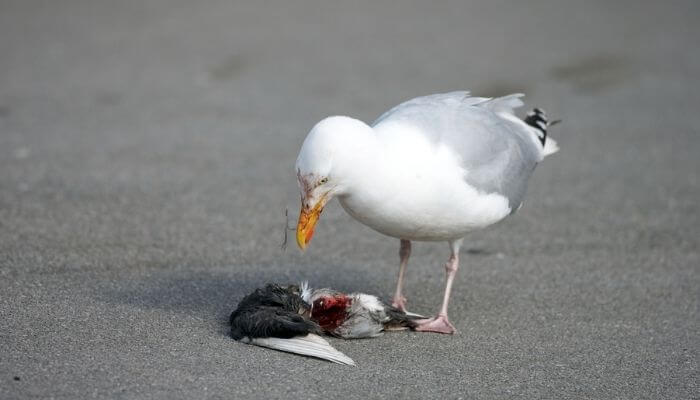
A pigeon may put up a spirited defence but doesn’t have any weapons.
A gull will happily kill and eat a pigeon, but a pigeon simply isn’t equipped to eat or kill another bird, let alone a gull!
